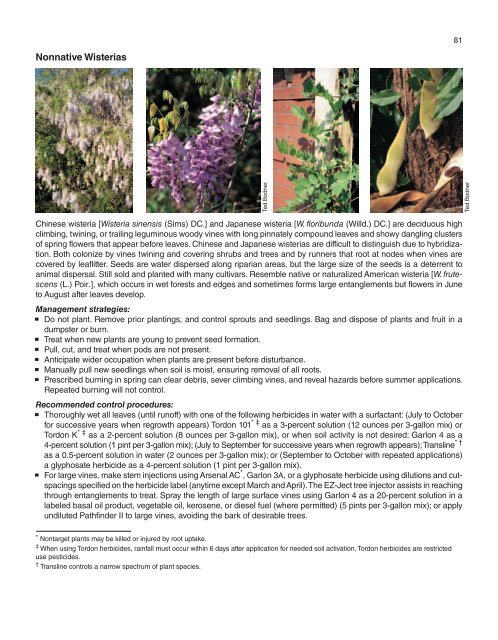A Management Guide for Invasive Plants in Southern Forests James ...
A Management Guide for Invasive Plants in Southern Forests James ...
A Management Guide for Invasive Plants in Southern Forests James ...
- No tags were found...
You also want an ePaper? Increase the reach of your titles
YUMPU automatically turns print PDFs into web optimized ePapers that Google loves.
81Nonnative WisteriasTed BodnerTed BodnerCh<strong>in</strong>ese wisteria [Wisteria s<strong>in</strong>ensis (Sims) DC.] and Japanese wisteria [W. floribunda (Willd.) DC.] are deciduous highclimb<strong>in</strong>g, tw<strong>in</strong><strong>in</strong>g, or trail<strong>in</strong>g legum<strong>in</strong>ous woody v<strong>in</strong>es with long p<strong>in</strong>nately compound leaves and showy dangl<strong>in</strong>g clustersof spr<strong>in</strong>g flowers that appear be<strong>for</strong>e leaves. Ch<strong>in</strong>ese and Japanese wisterias are difficult to dist<strong>in</strong>guish due to hybridization.Both colonize by v<strong>in</strong>es tw<strong>in</strong><strong>in</strong>g and cover<strong>in</strong>g shrubs and trees and by runners that root at nodes when v<strong>in</strong>es arecovered by leaflitter. Seeds are water dispersed along riparian areas, but the large size of the seeds is a deterrent toanimal dispersal. Still sold and planted with many cultivars. Resemble native or naturalized American wisteria [W. frutescens(L.) Poir.], which occurs <strong>in</strong> wet <strong>for</strong>ests and edges and sometimes <strong>for</strong>ms large entanglements but flowers <strong>in</strong> Juneto August after leaves develop.<strong>Management</strong> strategies:Do not plant. Remove prior plant<strong>in</strong>gs, and control sprouts and seedl<strong>in</strong>gs. Bag and dispose of plants and fruit <strong>in</strong> adumpster or burn.Treat when new plants are young to prevent seed <strong>for</strong>mation.Pull, cut, and treat when pods are not present.Anticipate wider occupation when plants are present be<strong>for</strong>e disturbance.Manually pull new seedl<strong>in</strong>gs when soil is moist, ensur<strong>in</strong>g removal of all roots.Prescribed burn<strong>in</strong>g <strong>in</strong> spr<strong>in</strong>g can clear debris, sever climb<strong>in</strong>g v<strong>in</strong>es, and reveal hazards be<strong>for</strong>e summer applications.Repeated burn<strong>in</strong>g will not control.Recommended control procedures:Thoroughly wet all leaves (until runoff) with one of the follow<strong>in</strong>g herbicides <strong>in</strong> water with a surfactant: (July to October<strong>for</strong> successive years when regrowth appears) Tordon 101 * ‡ as a 3-percent solution (12 ounces per 3-gallon mix) orTordon K * ‡ as a 2-percent solution (8 ounces per 3-gallon mix), or when soil activity is not desired: Garlon 4 as a4-percent solution (1 p<strong>in</strong>t per 3-gallon mix); (July to September <strong>for</strong> successive years when regrowth appears); Transl<strong>in</strong>e * †as a 0.5-percent solution <strong>in</strong> water (2 ounces per 3-gallon mix); or (September to October with repeated applications)a glyphosate herbicide as a 4-percent solution (1 p<strong>in</strong>t per 3-gallon mix).For large v<strong>in</strong>es, make stem <strong>in</strong>jections us<strong>in</strong>g Arsenal AC * , Garlon 3A, or a glyphosate herbicide us<strong>in</strong>g dilutions and cutspac<strong>in</strong>gsspecified on the herbicide label (anytime except March and April). The EZ-Ject tree <strong>in</strong>jector assists <strong>in</strong> reach<strong>in</strong>gthrough entanglements to treat. Spray the length of large surface v<strong>in</strong>es us<strong>in</strong>g Garlon 4 as a 20-percent solution <strong>in</strong> alabeled basal oil product, vegetable oil, kerosene, or diesel fuel (where permitted) (5 p<strong>in</strong>ts per 3-gallon mix); or applyundiluted Pathf<strong>in</strong>der II to large v<strong>in</strong>es, avoid<strong>in</strong>g the bark of desirable trees.* Nontarget plants may be killed or <strong>in</strong>jured by root uptake.‡ When us<strong>in</strong>g Tordon herbicides, ra<strong>in</strong>fall must occur with<strong>in</strong> 6 days after application <strong>for</strong> needed soil activation. Tordon herbicides are restricteduse pesticides.† Transl<strong>in</strong>e controls a narrow spectrum of plant species.
















